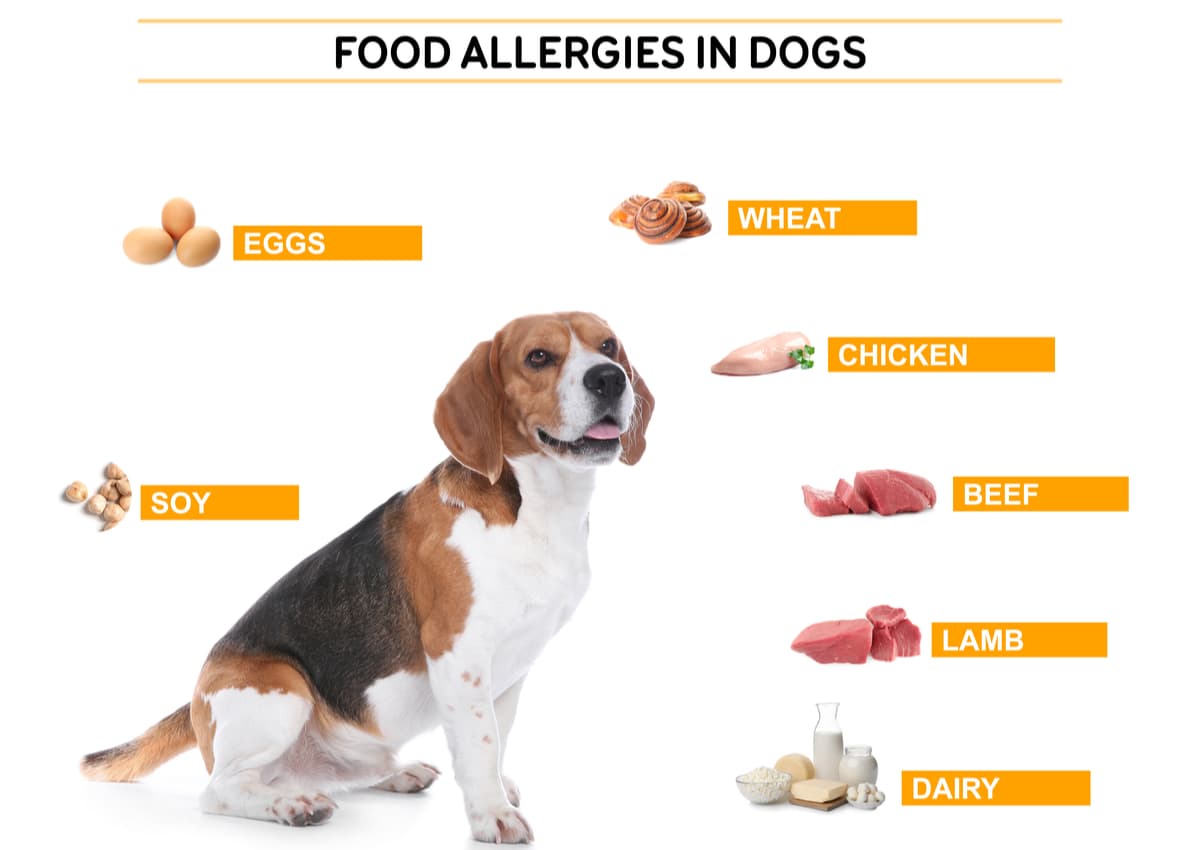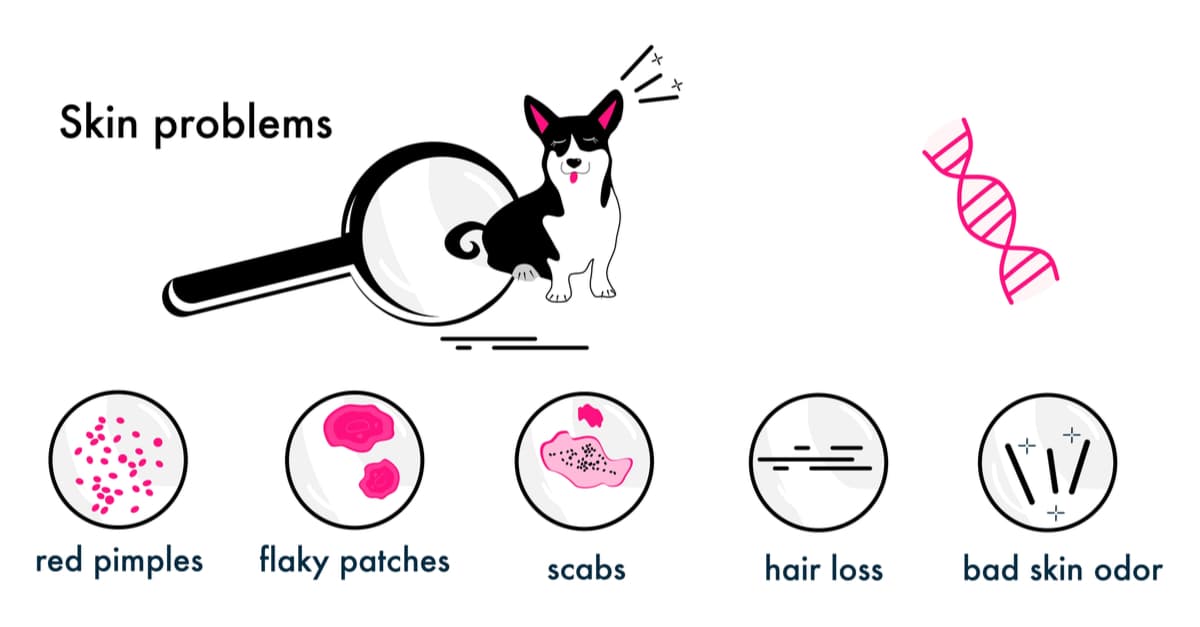Allergy is defined as an abnormal body reaction through specific antibodies because it responds exaggeratedly when it comes into contact with a substance from the outside, that other individuals do not normally react to and which should normally be tolerated. These substances are called allergens. An allergic reaction is thus an exaggerated defensive attempt that occurs in certain dogs that we call allergic. It is not known exactly why some are allergic to some substances and not to others. The most common dog skin allergies are caused by food and environmental allergies, the latter also known as atopic dermatitis. Dogs can also develop contact allergies, and in some cases, it is not possible to determine exactly what the animal is allergic to.
Causes of Allergies In Dogs

There are a lot of causes of allergies in dogs, usually expressed through the skin. It will depend on the route of contact whether this is considered atopic (if it comes into contact with the respiratory system), dermal (if the consequences appear after physical contact), or due to food:
- Food: This occurs when one or more of the ingredients in the dog’s food causes the immune system to become hypersensitive. Common allergens are corn, wheat, chicken, eggs, beef, soya, and milk derivatives.
- Atopic: in this case, the dog is allergic to some substance that it breathes or sniffs. Two common allergens are cigarette smoke and pollen. This type of allergy is the second most common in dogs.
- Dermal: These dog skin allergies develop when allergens come too close to be in direct contact with the dog’s skin. Common causes of dog skin allergies coming from a dermal source are flea collars, collars with other dewormers, shampoos, fertilizers, medicines, textile fibers in dog clothing, carpet fibers, insecticides, and chemical compounds in cleaning products. Others are caused by insect bites and are the most common cause of dog skin allergies. The most common are allergies to flea saliva and tick saliva.
Symptoms of Dog Skin Allergies

The first thing you’ll notice is a change in your dog’s behavior; they’ll itch and scratch a lot more than usual, either in one specific place on their body or all over. If you check him out, you may find that he has the kind of symptoms you would associate with an allergy in a human. Dogs have different ways of telling you there is a problem with their skin. Here are the most common manifestations of any skin allergy:
- Itching: If your dog frequently scratches all over his body, licks himself a lot, or bites his skin, he could be suffering from dermatitis. Note that the intensity of the itching is so intense that sometimes the dog’s skin can be injured by the scratching rather than the disease itself.
- Dandruff: Dogs have seasonal bouts of dandruff, but if dandruff remains longer than normal and covers the entire body, it could be dermatosis. Look for dandruff on his blanket or bedding.
- Otitis: If your dog suffers from frequent otitis, it is likely to be caused by dermatitis.
- Alopecia: some dermatoses manifest with hair loss.
Other symptoms to look out for: scabs or rashes, warmer areas on his body, redness or inflammation, dryness or irritation, blood clots, and skin discoloration.
Treatment

The treatment of an allergic dog is always individually adjusted according to the dog’s symptoms, the degree of itching and discomfort, and the possibilities of the dog’s owner. On the one hand, treatment will be aimed at avoiding what the dog cannot tolerate (food or something in its environment that can be changed). On the other hand, cortisone tablets or capsules, cyclosporine, or other drugs will be administered to help control the irritation and itching sensation.
Many dogs are also treated with allergy vaccines (immunotherapy), i.e., a vaccine containing the substances that the dog cannot tolerate is produced and administered as an injection or oral spray. A lot of dogs have a positive response to this treatment, which has null side effects. Allergy vaccination is intended to reduce the administration of other drugs. Sometimes we have to combine several treatments to alleviate the discomfort. Most dogs are also treated with external shampoos or sprays to prevent bacterial or fungal infections that may intensify the itching. Initially, the dog is usually bathed daily or every other day, and then, once the allergy is more under control, at longer intervals.
The shampoos used have different mechanisms of action and may be bactericidal, antipruritic, or anti-dandruff. The appropriate shampoo should be used, making sure to leave it on for 5-10 minutes before rinsing. It is important to rinse out all shampoo. Many dogs also require regular ear cleaning and treatment in cases of otitis.
Omega 3/6 fatty acid supplements are also part of the treatment, as the skin barrier of allergic animals is impaired and needs to be restored. Also, fatty acids have a certain antipruritic (itch relieving) effect. These fatty acids can also be enriched in feed for allergic dogs.
Allergy symptoms in dogs are a major source of discomfort for them and are easy to detect. Having treatment for the symptoms, as well as avoiding areas known to contain air pollutants, can help a lot.
If necessary, you can always consult your vet about allergy testing to determine the exact causes. With a series of injections, we can often eliminate allergic reactions. Remember that owning a pet is a big responsibility and that by having it at home, we are the ones who have to provide it with the best possible life, taking into account its physical and emotional needs and covering aspects from its happiness to the health of its skin.

